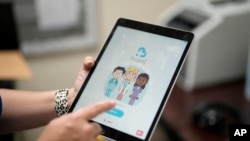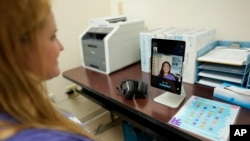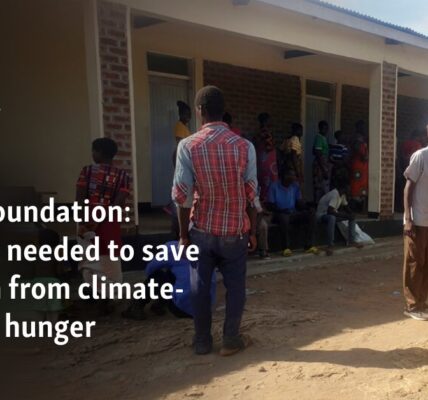With a shortage of counselors, schools in the US are relying on the thriving industry of virtual therapy.
Maria Ishoo’s daughter began experiencing problems with bullies at a young age. Other girls would team up and taunt her with insults like “fat” and “ugly,” while boys physically harassed her by tripping and pushing her. This caused Maria, a mother from California, to witness her normally outgoing second-grade daughter withdraw and spend her afternoons hiding under the covers in her bedroom.
Valerie Aguirre’s daughter in Hawaii experienced a series of middle school conflicts known as “friend drama” that eventually led to physical violence and cyberbullying. As a result, the 12-year-old felt isolated and unhappy.
Both kids were provided assistance through teletherapy, a service being offered by schools nationwide due to the increasing mental health challenges faced by American youth.
According to a study by The Associated Press, online therapy sessions are now being offered by at least 16 of the top 20 public school districts in the United States. These districts have collectively signed contracts worth over $70 million with therapy providers in order to reach a vast number of students.
The growth reflects a booming new business born from America’s youth mental health crisis, which has proven so lucrative that venture capitalists are funding a new crop of school teletherapy companies. Some experts raise concerns about the quality of care offered by fast-growing tech companies.
Educators have found that teletherapy is a viable solution for many students, as it helps to address the lack of in-person practitioners in schools. This method has been especially beneficial for students from rural areas and those from lower-income families, as it has made therapy more accessible. Schools now allow students to connect with online counselors at any time during the school day or even from the comfort of their own homes outside of school hours.
Ishoo, a mother of two in Lancaster, California, suggested a method to avoid people slipping through the cracks.
Ishoo remembers standing outside her second-grader’s bedroom last year and hoping to communicate with her. She would ask, “What’s troubling you?” but the answer would weigh heavily on her heart: “It’s NOTHING, Mom.”
During the previous spring, the school district implemented a teletherapy program, which she enrolled her daughter in. For four weeks, the girl participated in weekly sessions from her bedroom and connected with a therapist who provided her with methods for managing her anxiety, such as breathing techniques. The therapist encouraged the girl by saying: You have the power to control your emotions. Do not let anyone else have that power over you.
Ishoo stated that she discovered the importance of asking for assistance and that it is normal to need additional support at times.
According to Trish Wilson, the coordinator of counselors for the Lancaster school district, the system has 13,000 students and employs counselors and psychologists, but the demand outweighs the available resources.
According to her, therapists in the vicinity are fully booked and are unable to refer students for immediate treatment. However, students can schedule a virtual session within a few days.
Wilson stated that their preferred method of therapy is in-person for students. However, they acknowledge that this is not always feasible. Wilson’s district has directed over 325 students to participate in more than 800 online therapy sessions since the program’s launch.
During interviews, students and their parents mentioned that they had resorted to teletherapy due to difficulties with emotions such as sadness, loneliness, and anxiety, as well as academic stress. The return to in-person schooling after a period of distance learning was often distressing for many, as friendships were strained, social skills declined, and there was a tendency for tempers to flare more easily.
Educational institutions are covering the costs, with a significant portion utilizing funds from federal relief efforts, in response to experts’ concerns about rising levels of depression, anxiety, and suicide among young people. Numerous school districts are engaging in agreements with private businesses, while others are collaborating with community healthcare providers, non-profit organizations, or state initiatives.
Mental health professionals are appreciative of the additional assistance, but warn of potential challenges. One concern is the increasing difficulty in recruiting school counselors and psychologists, exacerbated by competition with telehealth services.
Doreen Hogans, the supervisor of school counseling in Prince George’s County, Maryland, stated that the presence of 44 counselor vacancies has been greatly affected by telehealth. She estimates that approximately 20% of the previous school counselors have left to pursue opportunities in teletherapy, which often provides more adaptable schedules.
The quick expansion of these companies brings up concerns regarding the therapists’ qualifications, experience working with children, and privacy policies. Kevin Dahill-Fuchel, the executive director of Counseling in Schools, a nonprofit organization that supports schools in providing traditional, face-to-face mental health services, made this statement.
“He expressed a desire to receive updates on the coverage of all other bases as we provide telehealth access to young individuals.”
Hazel Health, a major provider headquartered in San Francisco, initially focused on offering telemedicine services in schools in 2016. However, CEO Josh Golomb stated that the company has since expanded to include mental health services as of May 2021. With over 300 clinicians on staff, Hazel Health now offers teletherapy to more than 150 school districts across 15 states.
Hazel’s rapid growth has resulted in millions of dollars in revenue. This year, the company secured a $24 million agreement with Los Angeles County to provide teletherapy services to 1.3 million students for a duration of two years.
Other customers, such as the state of Hawaii, have agreed to pay Hazel a total of $4 million over a period of three years to assist with their public school programs. Additionally, the school district of Clark County in the Las Vegas region has set aside $3.25 million for teletherapy services provided by Hazel. Hazel has also formed partnerships with the districts of Miami-Dade, Prince George’s, and Houston schools.
Hazel’s priority is prioritizing child welfare over financial gain, despite their large contracts, according to Golomb.
According to Golomb, although we operate as a nonprofit, we are utilizing a private-sector approach to reach a wide audience of children. Thanks to a $51.5 million investment in 2022, Hazel was able to grow and expand. As for any worries about a potential decrease in quality, the answer is a clear no.
Other providers are getting into the space. In November, New York City launched a free telehealth therapy service for teens to help eliminate barriers to access, said Ashwin Vasan, the city’s health commissioner. New York is paying the startup TalkSpace $26 million over three years for a service allowing teens aged 13 to 17 to download an app and connect with licensed therapists by phone, video or text.
New York is providing this service to teenagers regardless of whether they attend private, public, or homeschools, or are not currently enrolled in school.
Vasan expressed his hope that this will make mental health care more accessible and democratic for young individuals.
A significant number of referrals in Hawaii originate from schools located in rural or isolated regions. According to Fern Yoshida, who manages teletherapy for the state’s education department, there has been a significant rise in student clients in Maui since the fatal wildfires in August. As of this autumn, students have participated in 2,047 teletherapy sessions, representing a three-fold increase compared to the previous year.
Valerie Aguirre’s daughter experienced a physical altercation with two friends in sixth grade. One of the girls slapped her daughter, causing a rift between them. Aguirre recommended that her daughter try teletherapy. After two months of receiving therapy online, her daughter’s mindset improved as she came to understand that everyone makes mistakes and friendships can be repaired.
Ishoo, who lives in California, reports that her third grade daughter is passing on knowledge to her younger sister who just began kindergarten this year.
Ishoo shared that she accompanies her younger sibling to class and offers words of comfort. She has grown and gained wisdom. She provides reassurance to her sister, stating, “If classmates are unkind, just try to disregard their actions.”
Source: voanews.com






